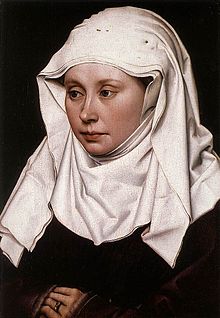| It has been suggested that Guimpe be merged into this article. (Discuss) Proposed since December 2024. |


A wimple is a medieval form of female headcovering, formed of a large piece of cloth worn draped around the neck and chin, covering the top of the head; it was usually made from white linen or silk. Its use developed in early medieval Europe; in medieval Christianity it was unseemly for a married woman to show her hair. A wimple might be elaborately starched, creased and folded in prescribed ways. Later elaborate versions were supported on wire or wicker framing, such as the cornette.
Italian women abandoned their head coverings in the 15th century or replaced them with transparent gauze, showing their braids. Elaborate braiding and elaborately laundered clothes demonstrated status, because such grooming was performed by others. Today a plain wimple is worn by the nuns of certain orders who retain a traditional habit.
In literature
The Wife of Bath and the Prioress are depicted wearing wimples in the Canterbury Tales of Geoffrey Chaucer (c. 1343 – 1400).
The King James Version of the Bible explicitly lists wimples in Isaiah 3:22 as one of a list of female fineries; however, the Hebrew word "miṭpaḥoth" (מִטְפָּחוֹת) means "kerchief".
Marvel’s The Scarlet Witch was originally conceived by artist Jack Kirby as wearing a peaked red wimple. In the decades since, it has been reduced in size and evolved into more of a tiara.
See also
References
- Macklin, Herbert Walter; Page-Phillips, John (January 13, 1969). "Monumental brasses". New York, Praeger. Retrieved January 13, 2024 – via Internet Archive.
- Macklin, Herbert Walter & Page-Phillips, John, (Eds.), 1969, p. 69
- Heron, Lynford (January 18, 2003). "Woman, Prayer & Head Covering". Centurion Ministry. Archived from the original on 2010-03-18.
External links
- [REDACTED] Media related to Wimple at Wikimedia Commons
